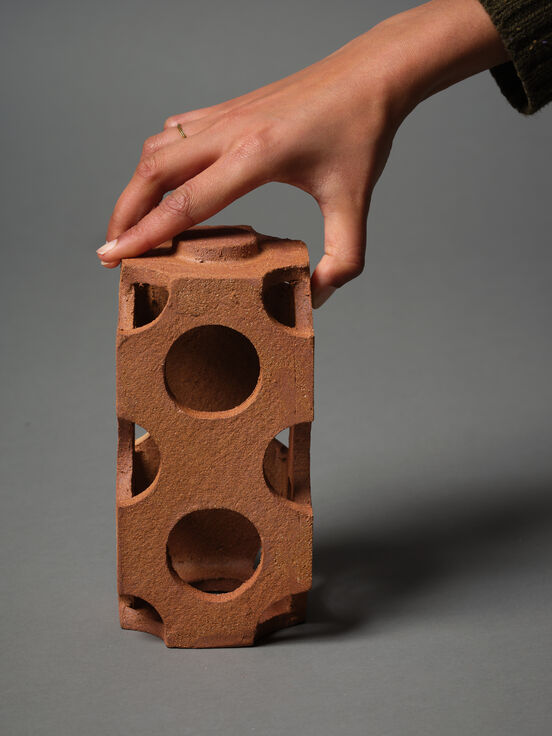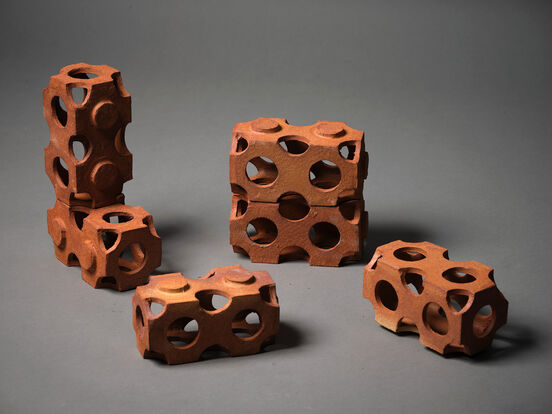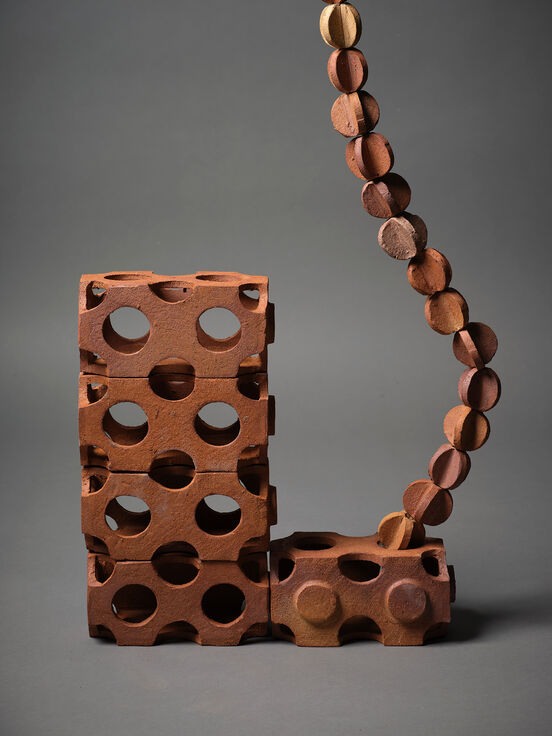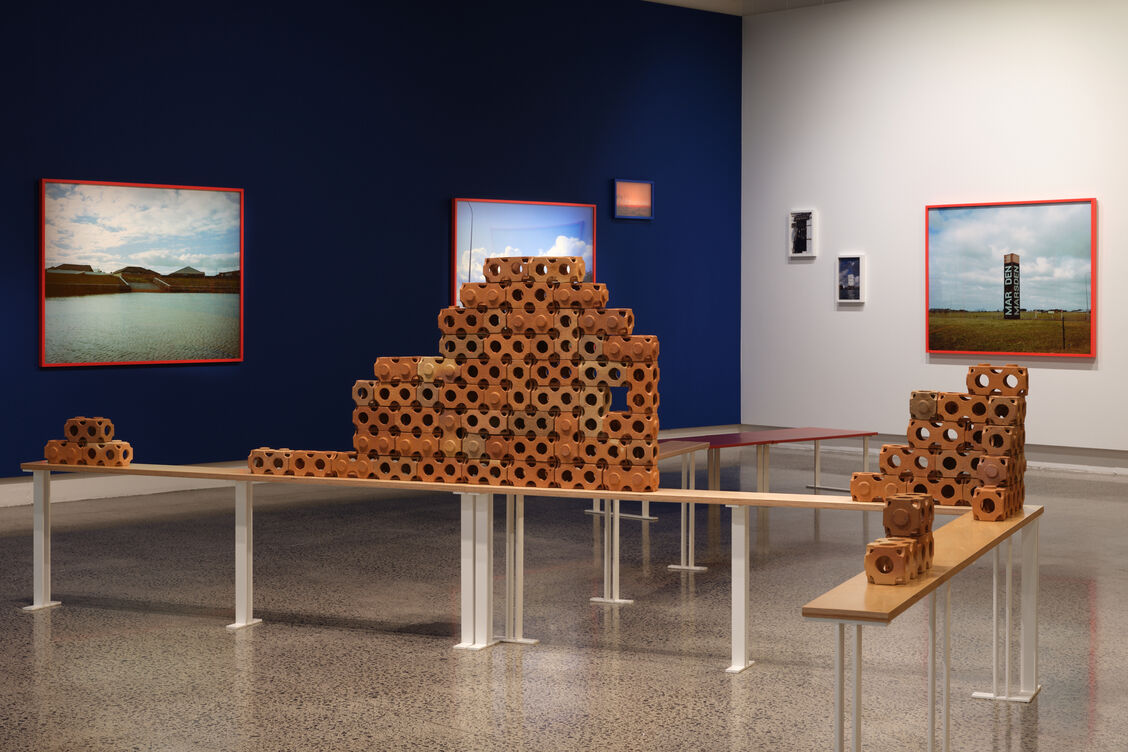-
Author
Eu Jin Chua -
Date
16 Nov 2021
Essay
Toro Whakaara: Isobel Thom
Isobel Thom is building, from ground up, a small house and studio for herself in the Waitākeres, in collaboration with architects James Fenton and Stephen Lloyd. A bit of it is on show in the Auckland portion of Toro Whakaara: a wall of handmade ceramic bricks that will revert to the house after having been exhibited as artwork.
The almost-completed building is a three-storey tower on a steep hillside (one room per storey: workshop, living, mezzanine). But it’s no bunker or fortress; the watchword is openness. The perforations in the ceramic bricks tell the principle of the whole thing. One side of the house is double-height louvred glass; the other side has an even higher clerestory window. The idea is for air to sweep from one end of the house to the other; in summer, hot air escapes via convection currents (the chimney effect). Interior partitions are perforated ceramic so as not to impede this open-plan vaporousness.
Moreover, the site is off grid and sustained by the skies. Appliances and hot showers are powered by the sun. Water is gravity-fed from rain tanks higher up. The outhouse toilet makes compost for the terraced garden. The exterior is to be clad with thousands of Thom’s handmade ceramic tiles, fired in an onsite kiln.
The house is part of a longstanding Kiwi tradition: the artist’s shed. In Berlin and New York, the stereotype is of artists working in industrial loft apartments. In New Zealand, we tend to picture artists and poets working in their shed or garage, perhaps especially in the Waitākere bush (Sargeson in his shed or McCahon in that bohemian hub of Auckland, Titirangi).
The damp and rain of the bush makes extra demands. (Auckland in general, let alone the Auckland bush, experiences higher annual relative humidity than every major city in North America. West Auckland experienced damaging floods just this past month.) So Thom’s house works with the elements rather than battling them and this kind of ecological approach is perhaps especially admirable when we’re talking about a house in a semi-wild, semiurbanised part of New Zealand.
But how are we to view the ceramic bricks in the gallery? I think a particular mode of looking is required and should be specified. The problem is that certain difficult questions are always posed when galleries exhibit functional objects meant for contemporary domestic use: Why have they been ripped out of their functional setting? Why have they been isolated and decontextualised — sometimes pedestalised, sealed in vitrines, and romanticised under spotlights — as opposed to being worn, sat on, drunk from, cooked in, leaned against? Why do we transform their utility into preciousness of another kind, into aesthetic (and often mercantile) value? We have become so used to seeing functional objects abstracted in this way in design galleries that we forget that this is an odd and problematic thing to do to them.
The way to resolve this is to be very clear about what happens when a functional design object is displayed in a gallery setting: we look through them to see the way of life that they represent. (Whereas we look at a painting or sculpture.) I may experience aesthetic pleasure from looking at the chromatic gleam of a Barcelona Chair in a design museum, but this pleasure should arguably be understood as secondary to my more primary sense that there is something bigger ‘behind’ the gleam: namely, the utopian way of life envisioned by the Modernists, of which that chair is a working part. If we did not intuitively understand this, then all design galleries would be no more than glorified gift-shops or investment advisors for wealthy collectors. They are not that (or not only that) because there is such a thing as this utopian mode of looking ‘through’. ¹
This sense of looking through a functional object to see utopia ‘behind’ it is extraordinarily true of Thom’s practice, which has indeed involved exhibiting objects of everyday use in galleries. These ceramic objects tell us about new ways of living: how we might live if we were free of the entrenched world of Kmart consumerism, wage economies, privatised power companies and carbon emissions. A utopia unsullied by debt, capital, and pollution is not here yet. But what if we just lived less dysfunctionally by capturing our own water and electricity, growing our own food, and making what we need in the kiln downstairs, including the means of shelter itself ?
—
Born in Tāmaki Makaurau Auckland, Isobel Thom graduated with a Master of Fine Arts in 1990 from the University of Auckland, then lived and worked in New York from 1995 to 2005. She then returned to Elam to undertake a doctorate in Fine Arts, from which she graduated in 2011. She has been developing functional ceramics over the last decade that are informed by her previous practice as a painter. She has exhibited these widely and is currently building a small house/studio in Tāmaki Makaurau that incorporates much of this recent output.
Eu Jin Chua is a researcher and writer. He has contributed to books, journals, and exhibition catalogues in Aotearoa New Zealand and overseas. His background is in film, architecture and cultural theory, and he currently teaches in Fine Arts at the University of Auckland. 1. I may be restating, in different terms, the argument put forward in Stephen Greenblatt’s essay “Resonance and Wonder”, in Exhibiting Cultures: The Poetics and Politics of Museum Display, ed. Ivan Karp and Steven D. Lavine, Washington, DC: Smithsonian Institution Press, 1991.
—
This text is republished from Toro Whakaara: Responses to our built environment, a publication produced by Objectspace to accompany an exhibition of the same name. The publication is edited by Tessa Forde, and copy-edited by Anna Hodge.

(above & below) Isobel Thom, Bricks, 2021. Photograph by Samuel Hartnett.


Isobel Thom, Bricks and Rainchain, 2021. Photograph by Samuel Hartnett.

Installation view of Isobel Thom, Bricks, 2021 in Toro Whakaara: Responses to our built environment, with Ngahuia Harrison's ongoing series Coastal Cannibals in the background. Photograph by Samuel Hartnett.